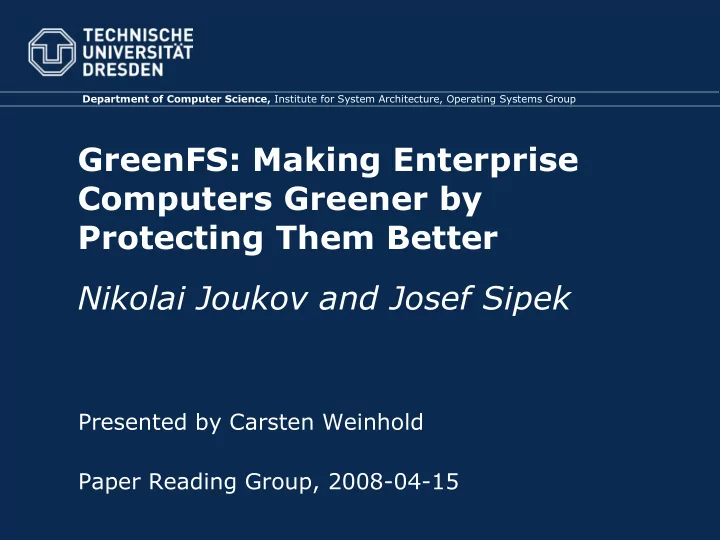

Department of Computer Science, Institute for System Architecture, Operating Systems Group GreenFS: Making Enterprise Computers Greener by Protecting Them Better Nikolai Joukov and Josef Sipek Presented by Carsten Weinhold Paper Reading Group, 2008-04-15
Motivation Observations: – Data is irreplaceable asset of high value – Disks are fragile – Disks consume energy – Disks are noisy Current solution: Spin up / down – Disks wear out: • 50,000 cycles for desktop disks • 600,000 cycles for laptop disks – Ineffective against unexpected shocks – User inconvenience Paper Reading Group, 2008-04-15 GreenFS Slide 2 of 17
GreenFS Design Key idea: minimize number of active disks – Reduce shock susceptibility – Reduce energy consumption – Use flash memory to hold working set (+ version history) Design goals: – Usable for laptops, desktops, servers – Designed for enterprise environment: • Centralized servers • High-bandwidth network – Support disconnected operation Paper Reading Group, 2008-04-15 GreenFS Slide 3 of 17
GreenFS Architecture Figure copied from GreenFS paper. Paper Reading Group, 2008-04-15 GreenFS Slide 4 of 17
Buffered All-Time Protection • Run-time backup (Continuous Data Protection) • All updates sent to remote server • Remote server may keep versions • Flash memory used as cache: – Recently used files – Version history of updates, if disconnected • Flash memory + remote server store complete history Paper Reading Group, 2008-04-15 GreenFS Slide 5 of 17
Reversed Backup Operation Reversed roles of backup server and local disk: • Remote server: – Receives all data updates – Keeps version history • Local disk: – Inactive most of time – Keeps backup of data on server • Local disk synchronized on: – Shutdown, regular intervals – Memory pressure (disconnected operation) – Large large writes Paper Reading Group, 2008-04-15 GreenFS Slide 6 of 17
All-Data Protection All data of all machines stored on remote server. • Energy efficient, because server is shared • How to reduce costs for storage? – Redundant data elimination – Hierarchical backup – Not deeply discussed in paper Paper Reading Group, 2008-04-15 GreenFS Slide 7 of 17
Reliability • Connected Operation: – All data stored redundantly on remote server – All updates sent immediately – Updates may / may not be written to disk – Crash: local disk gets synchronized on boot • Disconnected Operation: – Local disk spins up on demand – Servers / desktops: keep disk spinning – Laptops: minimize time disk is spinning • Flash memory is robust Paper Reading Group, 2008-04-15 GreenFS Slide 8 of 17
Power, Reliability & User Experience Authors claim: power efficiency, reliability and user convenience are not mutually exclusive! • Local disk in standby: – Consumes little power – Totally silent – Shock resilient • Disk spins up for constant reads / writes • Break even: power for disk / network Paper Reading Group, 2008-04-15 GreenFS Slide 9 of 17
GreenFS Implementation Figure copied from GreenFS paper. Paper Reading Group, 2008-04-15 GreenFS Slide 10 of 17
Application Launch Benchmark Figure copied from GreenFS paper. Paper Reading Group, 2008-04-15 GreenFS Slide 11 of 17
OpenSSH Compile Benchmark Figure copied from GreenFS paper. Paper Reading Group, 2008-04-15 GreenFS Slide 12 of 17
Power Efficiency Estimation of power savings: Figure copied from GreenFS paper. Paper Reading Group, 2008-04-15 GreenFS Slide 13 of 17
Shock Exposure Benchmark: – Notebook carried around – Disk is active Figure copied from (Samsung HM500LI: shocks up to 750G GreenFS paper. when inactive, up to 325G when spinning) Paper Reading Group, 2008-04-15 GreenFS Slide 14 of 17
Summary • Modular design • Stackable file system • COTS hardware • Base on existing components: – UNIONFS – Cryptfs, VersionFS, Ext3cow, ... – NFS Paper Reading Group, 2008-04-15 GreenFS Slide 15 of 17
Discussion Points • Interesting solution to important problem ... to become obsolete with SSDs? • Evaluation: – Size of flash memory? What if too small? – Power consumption of laptop USB ports? – Redundant Data Elimination? • Power saving & laptop disks • Windows Vista & hybrid disks (“Ready Drive”) Paper Reading Group, 2008-04-15 GreenFS Slide 16 of 17
References • Nikolai Joukov and Josef Sipek, “GreenFS: Making Enterprise Computers Greener by Protecting Them Better” , EuroSys 2008, Glasgow • http://www.heise.de/newsticker/Flache-Notebookplatten-mit-500- GByte--/meldung/106339/from/rss09 Paper Reading Group, 2008-04-15 GreenFS Slide 17 of 17
Power Trade Off: Disk or Network Energy consumption: Paper Reading Group, 2008-04-15 GreenFS Slide 18 of 17
Recommend
More recommend